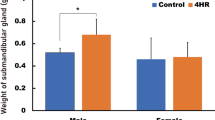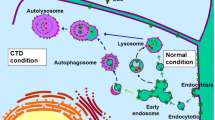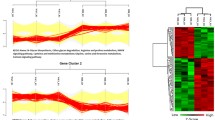Abstract
The parotid gland is the largest salivary gland. It produces watery saliva, rich in proteins (amylase, lysozymes, and antibodies). Due to the gland’s morphological cytoarchitecture composed of only serous acini, it contributes almost 50% of total salivary volume upon stimulation. It has been reported that the prevalence of saliva secretion impairments, periodontitis, delayed wound healing, and xerostomia increase in diabetic patients. Herein we evaluated the acute effects of insulin on insulin receptor phosphorylation status and its substrates IRS-1 and IRS-2 in the parotid glands of adult male Wistar rats, using Western blot analyses. We confirmed an acute effect of insulin on IR/IRS/PI3K/Akt and MAPK intracellular pathway activation in the parotid glands of male Wistar rats similar to the classical metabolic targets of the hormone, like the liver.



Similar content being viewed by others
References
White, M. F., Shoelson, S. E., Keutmann, H., & Kahn, C. R. (1988). A cascade of tyrosine autophosphorylation in the beta-subunit activates the phosphotransferase of the insulin receptor. Journal of Biological Chemistry, 263(6), 2969–2980.
Cheatham, B., & Kahn, C. R. (1995). Insulin action and the insulin-signaling network. Endocrine Review, 16, 117–142.
Cuatrecasas, P. (1969). Interaction of insulin with the cell membrane: the primary action of insulin. Biochem, 63, 450–457.
Cuatrecasas, P. (1972). Affinity chromatography and purification of the insulin receptor of liver cell membranes. Proceedings of the National Academy of Sciences of the United States of America, 69, 1277–1281.
Freychet, P., Roth, J., & Neville, D. M. (1971). Monoiodoinsulin: demonstration of its biological activity and binding to fat cells and liver membranes. Biochemical and Biophysical Research Communications, 43(2), 400–408.
Freychet, P., Roth, J., & Neville, D. M. (1971). Insulin receptor in the liver: specific bindidng of [125I] insulin to the plasma membrane and its relation to insulin bioactivity. Proceedings of the National Academy of Sciences of the United States of America, 68, 1833–1837.
Kahn, C. R. (1985). Molecular mechanism of insulin action. Annual Review of Medicine, 36, 429–451.
Patti, M. E., & Kahn, C. R. (1998). The insulin receptor—a critical link in glucose homeostasis and insulin action. Journal of Basic and Clinical Physiology and Pharmacology, 9, 89–109.
Kasuga, M., Karlsson, F. A., & Kahn, C. R. (1982). Insulin stimulates the phosphorilation of the 95.000 dalton subunit of its own receptor. Science, 215, 185–187.
Ullrich, A., & Schlessinger, J. (1990). Signal transduction by receptors with tyrosine kinase activity. Cell, 61(2), 203–212.
Cahill, G., & FJr (1971). Phisiology of insulin in man. Diabetes, 20, 785–799.
Sun, X. J., Rothenberg, P., Kahn, C. R., Backer, J. M., Araki, E., Wilden, P. A., Cahill, D. A., Goldstein, B. J., & White, M. F. (1991). Structure of the insulin receptor substrate IRS-1 defines a unique signal Transduction protein. Nature, 352, 73–77.
Sun, X. J., Wang, L. M., & Zhang, Y., et al. (1995). The structure and function of 4PS reveals IRS-2: A common interface in insulin and cytokine signaling. Nature, 374, 442–446.
Folli, F., Saad, M. J. A., Backer, J. M., & Kahn, C. R. (1992). Insulin stimulation of phosphatidylinositol 3-kinase and association with insulin receptor substrate 1 in liver and muscle of the intact rat. Journal of Biological Chemistry, 267, 22171–22177.
Kohn, A. D., Summers, S. A., Birnbaum, M. J., Roth, R. A. (1996). Expression of a constitutively active AKT Ser/Thr Kinase in 3T3-L1 adipocytes stimulates glucose uptake and glucose transporter 4 translocation. Journal of Biological Chemistry, 6:271(49), 31372–31378.
Tanti, J. F., Grillo, S., Gremeaux, T., Coffer, P. J., Van Ibberghen, E., & Le Marchand-Brustel, Y. (1997). Potential role of protein Kinase B in glucose transporter 4 translocation in adipocytes. Endocrinology, 138(5), 2005–2010.
Krook, A., Roth, R. A., Jiang, X. J., Zierath, J. R., & Wallberg-Henriksson, H. (1998). Insulin-stimulated AKT Kinase activity is reduced in skeletal muscle from NIDDM subjects. Diabetes, 47(8), 1281–1286.
Shepherd, P. R., Nave, B. T., & Siddle, K. (1995). Insulin stimulation of glycogen synthesis and glycogen synthase activity is blocked by wortmannin and rapamycin in 3t3-L1 adipocytes: evidence for the involvement of phosphoinositide 3-Kinase and p70 ribosomal protein-S6 kinase. Journal of Biological Chemistry, 305, 25–28.
Kovacina, K. S., & Roth, R. A. (1993). Identification of shc as a substrate of the insulin receptor Kinase distinct from the GAP-associated 62 kDa tyrosine phosphoprotein. Biochemical and Biophysical Research Communications, 192, 1303–1311.
Wang, L. M., Myers, M. G., Sun, X., Aaronson, S. A., White, M., & Pierce, J. H. (1993). IRS-1: Essential for insulin and IL-4 stimulated mitogenesis in hematopoietic cells. Science, 261, 1591–1594.
Avruch, J. (1998). Insulin signal transduction through protein kinase cascades. Molecular and Cellular Biochemistry, 182(1-2), 31–48.
Boulton, T. G., Nye, S. H., Robbins, D. J., Ip, N. Y., Radziejewska, E., Morgenbesser, S. D., DePinho, R. A., Panayotatos, N., Cobb, M. H., & Yancopoulos, G. D. (1991). ERKs a family of protein-serine/threonine kinases that are activated and tyrosine phosphorylated in response to insulin and NGF. Cell, 65, 663–675.
Bakianian-Vaziri, P., Vahedi, M., Mortazavi, H., Abdollahzadeh, S. H., & Hajilooi, M. (2010). Evaluation of salivary glucose, IgA and flow rate in diabetic patients: a case‐control study. Journal of Dental Medicine - Tehran, 7, 13–18.
Indira, M., Chandrashekar, P., Kattappagari, K. K., Chandra, L. P., Chitturi, R. T., & BV, R. R. (2015). Evaluation of salivary glucose, amylase, and total protein in type 2 diabetes mellitus patients. Indian Journal of Dental Research, 26, 271–275.
Panchbhai, A. S., Degwekar, S. S., & Bhowte, R. R. (2010). Estimation of salivary glucose, salivary amylase, salivary total protein and salivary flow rate in diabetics in India. Journal of Oral Science, 52, 359–368.
Marín Martínez, L., Molino Pagán, D., & López Jornet, P. (2018). Trace elements in saliva as markers of type 2 diabetes mellitus. Biological Trace Element Research, 186, 354–360.
Chen, S. Y., Wang, Y., Zhang, C. L., & Yang, Z. M. (2020). Decreased basal and stimulated salivary parameters by histopathological lesions and secretory dysfunction of parotid and submandibular glands in rats with type 2 diabetes. Experimental and Therapeutic Medicine, 19(4), 2707–2719.
Rocha, E. M., Lima, M. H. M., Carvalho, C. R. O., Saad, M. J. A., & Velloso, L. A. (2000). Characterization of the insulin-signaling pathway in lacrimal and salivary glands of rats. Current Eye Research, 21(5), 833–842.
Rocha, E. M., Carvalho, C. R. O., Saad, M. A. J., & Velloso, L. A. (2003). The influence of ageing on the insulin signalling system in rat lacrimal and salivary glands. Acta Ophthalmologica Scandinavica, 81(6), 639–645.
Young, J. A., Van Lennep, D. W. (1978). The morphology of salivary glands. London, New York, Academic Press.
Mason, D. K., Chisholm, D. M. (1975). Salivary glands in health and disease. London, Philadelphia, Saunders.
Mascarenhas, P., Fatela, B., & Barahona, I. (2014). Effect of diabetes mellitus type 2 on salivary glucose-a systematic review and meta-analysis of observational studies. Plos One, 9(7), e101706.
Naseri, R., Mozaffari, H. R., Ramezani, M., & Sadeghi, M. (2018). Effect of diabetes mellitus type 2 on salivary glucose, immunoglobulin A, total protein, and amylase levels in adults: a systematic review and meta-analysis of case-control studies. Journal of Research in Medical Sciences, 23, 89
Pérez-Ros, P., Navarro-Flores, E., Julián-Rochina, I., Martínez-Arnau, F. M., & Cauli, O. (2021). Changes in salivary amylase and glucose in diabetes: a scoping review. Diagnostics, 11(3), 453.
Anderson, L. C., Garrett, J. R., Thulin, A., & Proctor, G. B. (1989). Effects of streptozocin-induced diabetes on sympathetic and parasym-pathetic stimulation of parotid salivary gland function in rats. Diabetes, 38, 1381–1389.
Laemmli, U. K. (1970). Cleavage of structural proteins during the assembly of the head of bacteriophage T4. Nature, 227, 680–685.
Copps, K. D., & White, M. F. (2012). Regulation of insulin sensitivity by serine/threonine phosphorylation of insulin receptor substrate proteins IRS1 and IRS2. Diabetologia, 55, 2565–2582.
Clarke, J. F., Young, P. W., Yonezawa, K., Kasuga, M., & Holman, G. D. (1994). Inhibition of the Translocation of GLUT1 and GLUT4 in 3T3-L1 cells by the Phosphatidylinositol 3-Kinase inhibitor, wortmannin. Biochem J, 300(Pt3), 631–635.
Tsakiridis, T., McDowell, H. E., Walker, T., Downes, C. P., Hundal, H. S., Vranic, M., & Klip, A. (1995). Multiple roles of phosphatidylinositol 3-kinase in regulation of glucose transport, amino acid transport, and glucose transporters in L6 skeletal muscle cells. Endocrinology, 136(10), 4315–4322.
Sanches-Margalet, V., Goldfine, I. D., Vlahos, C. J., & Sung, C. K. (1994). Role of PI 3-kinase in insulin receptor signaling: studies with inhibitor LY294002. Biochemical and Biophysical Research Communications, 204, 336–LY294452.
Limesand, K. H., Barzen, K. A., Quissel, D. O., & Anderson, S. M. (2003). Synergistic suppression of apoptosis in salivary acinar cells by IGF1 and EGF. Cell Death and Differentiation, 10, 345–355.
Hoseini, A., Mirzapour, A., Bijani, A., & Shirzad, A. (2017). Salivary flow rate and xerostomia in patients with type I and II diabetes mellitus. Electron Physician, 9(9), 5244–5249.
Newrick, P. G., Bowman, C., Green, D., O’Brien, I. A., Porter, S. R., Scully, C., & Corrall, R. J. (1991). Parotid salivary secretion in diabetic autonomic neuropathy. Journal of Diabetic Complications, 5(1), 35–37.
Mata, A. D., Marques, D., Rocha, S., Francisco, H., Santos, C., Mesquita, M. F., & Singh, J. (2004). Effects of diabetes mellitus on salivary secretion and its composition in the human. Molecular and Cellular Biochemistry, 261(1-2), 137–142.
Benguigui, C., Bongard, V., Ruidavets, J. B., Chamontin, B., Sixou, M., Ferrières, J., & Amar, J. (2010). Metabolic syndrome, insulin resistance, and periodontitis: a cross-sectional study in a middle-aged French population. Journal of Clinical Periodontology, 37(7), 601–608.
Timonen, P., Suominen-Taipale, L., Jula, A., Niskanen, M., Knuuttila, M., & Ylöstalo, P. (2011). Insulin sensitivity and periodontal infection in a non-diabetic, non-smoking adult population. Journal of Clinical Periodontology, 38(1), 17–24.
Tanakchi S., Aly F. Z. Anatomy & histology. PathologyOutlines.com, website. https://www.pathologyoutlines.com/topic/salivaryglandsnormalhistology.html.
Author information
Authors and Affiliations
Corresponding author
Ethics declarations
Conflict of Interest
The authors declare no competing interests.
Additional information
Publisher’s note Springer Nature remains neutral with regard to jurisdictional claims in published maps and institutional affiliations.
Rights and permissions
About this article
Cite this article
DeVito-Moraes, A.G., Marques, V.D.D., Caperuto, L.C. et al. INitial Steps of Insulin Action in Parotid Glands of Male Wistar Rats. Cell Biochem Biophys 80, 89–95 (2022). https://doi.org/10.1007/s12013-021-01025-5
Received:
Accepted:
Published:
Issue Date:
DOI: https://doi.org/10.1007/s12013-021-01025-5




